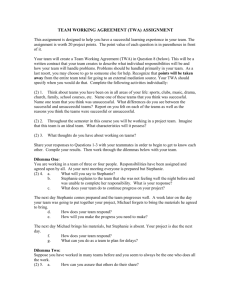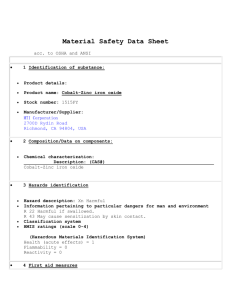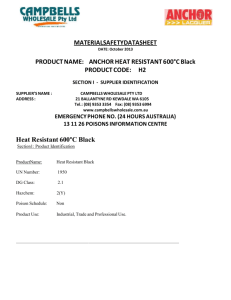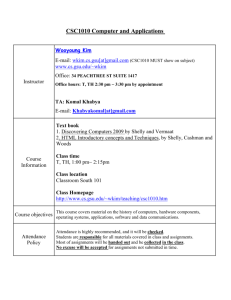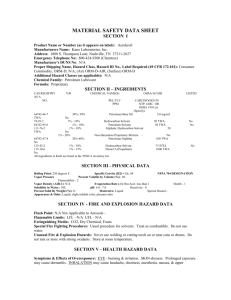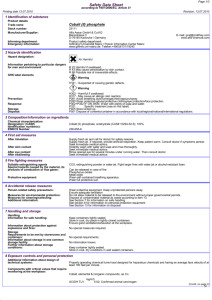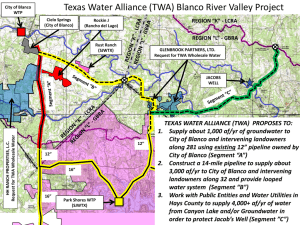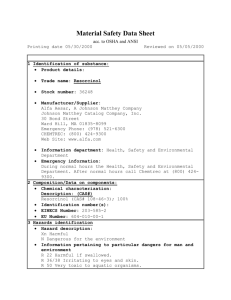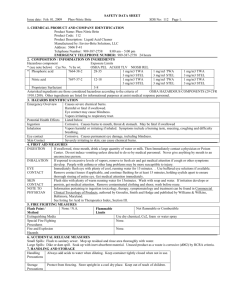Stellite 21 MSDS
advertisement
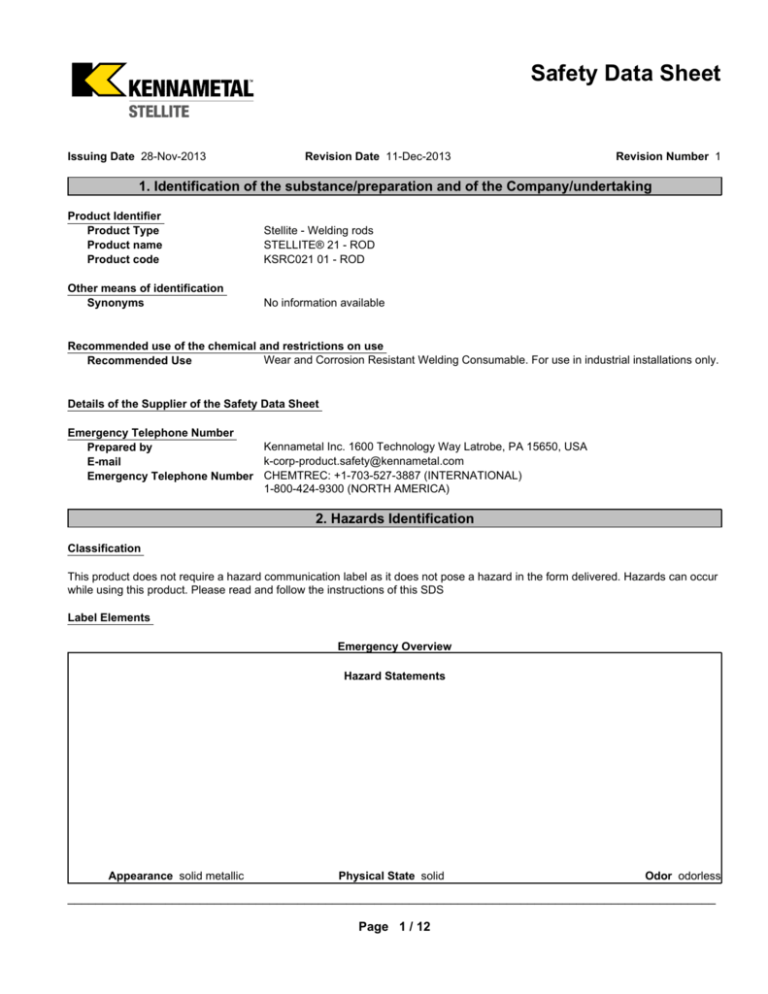
Safety Data Sheet Issuing Date 28-Nov-2013 Revision Date 11-Dec-2013 Revision Number 1 1. Identification of the substance/preparation and of the Company/undertaking Product Identifier Product Type Product name Product code Stellite - Welding rods STELLITE® 21 - ROD KSRC021 01 - ROD Other means of identification Synonyms No information available Recommended use of the chemical and restrictions on use Wear and Corrosion Resistant Welding Consumable. For use in industrial installations only. Recommended Use Details of the Supplier of the Safety Data Sheet Emergency Telephone Number Kennametal Inc. 1600 Technology Way Latrobe, PA 15650, USA Prepared by k-corp-product.safety@kennametal.com E-mail Emergency Telephone Number CHEMTREC: +1-703-527-3887 (INTERNATIONAL) 1-800-424-9300 (NORTH AMERICA) 2. Hazards Identification Classification This product does not require a hazard communication label as it does not pose a hazard in the form delivered. Hazards can occur while using this product. Please read and follow the instructions of this SDS Label Elements Emergency Overview Hazard Statements Appearance solid metallic Physical State solid Odor odorless _____________________________________________________________________________________________ Page 1 / 12 KSRC021 01 - ROD STELLITE® 21 - ROD Revision Date 11-Dec-2013 _____________________________________________________________________________________________ Precautionary Statements Prevention Obtain special instructions before use Do not handle until all safety precautions have been read and understood Use personal protective equipment as required Wash face, hands and any exposed skin thoroughly after handling Do not eat, drink or smoke when using this product Do not breathe dust/fume/gas/mist/vapors/spray Use only outdoors or in a well-ventilated area Wear respiratory protection In case of inadequate ventilation wear respiratory protection Contaminated work clothing should not be allowed out of the workplace Wear protective gloves/protective clothing/eye protection/face protection Precautionary Statements Response IF exposed or concerned: Get medical advice/attention Specific treatment is urgent (see supplemental first aid instructions on this label) Eyes IF IN EYES: Rinse cautiously with water for several minutes. Remove contact lenses, if present and easy to do. Continue rinsing If eye irritation persists: Get medical advice/attention Skin IF ON SKIN: Wash with plenty of soap and water If skin irritation or rash occurs: Get medical advice/attention Wash contaminated clothing before reuse Inhalation IF INHALED: Remove victim to fresh air and keep at rest in a position comfortable for breathing Immediately call a POISON CENTER or doctor/physician Ingestion IF SWALLOWED: Call a POISON CENTER or doctor/physician if you feel unwell Rinse mouth Precautionary Statements - Storage Store locked up. Store in a well-ventilated place. Keep container tightly closed. Precautionary Statements - DisposalDispose of contents/container to an approved waste disposal plant. Hazards not otherwise classified (HNOC) Welding Hazards OTHER INFORMATION Unknown Aquatic Toxicty CAUTION. Welding will create fumes which may be toxic. If welding is performed on plated or coated materials such as galvanised or painted steel, excessive fume may be produced which contains additional hazardous components, and may result in metal fume fever or other health effects. Radiation from the welding arc can cause burns to the skin and damage to the eyes. The product and work surface will be hot during and after welding. Electric shock can KILL. Arc Rays can injur eyes and burn skin. May be harmful if swallowed. Causes mild skin irritation. Very toxic to aquatic life with long lasting effects. Very toxic to aquatic life. 37.65% of the mixture consists of ingredient(s) of unknown toxicity 3. Composition/Information on Ingredients Chemical name Formula CAS-No weight-% GHS Classification _____________________________________________________________________________________________ Page 2 / 12 KSRC021 01 - ROD STELLITE® 21 - ROD Revision Date 11-Dec-2013 _____________________________________________________________________________________________ Cobalt Co 7440-48-4 > 50 Chromium Molybdenum Nickel Cr Mo 7440-47-3 7439-98-7 7440-02-0 25 - 50 5 - 10 2.5 - 3 7439-89-6 7440-21-3 7439-96-5 7440-44-0 7440-33-7 1 - 2.5 0.1 - 1 0.1 - 1 0.1 - 1 0.1 - 1 Iron Silicon Metal Manganese Carbon Tungsten Full text of H-Statements referred to under sections 2 and 3 Ni Fe Si Mn C W Acute oral 4 (H302) Acute dust/mist 1 (H330) Eye damage 2 (H319) Resp. Sens. 1B (H334) Skin Sens. 1 (H317) Carc. 1B (H350i) Repro. tox. 2 (H361f) Aquatic Acute 1 M=10 (H400) Aquatic Chronic 1 (H410) M=1 STOT RE 1 (H372) S,7 Carc. 2 (H351) S,7 Skin Sens. 1 (H317) S,7 Aquatic Chronic 3 (H412) H302 - Harmful if swallowed H317 - May cause an allergic skin reaction H319 - Causes serious eye irritation H330 - Fatal if inhaled H334 - May cause allergy or asthma symptoms or breathing difficulties if inhaled H350i - May cause cancer if inhaled H351 - Suspected of causing cancer if inhaled H361f - Suspected of damaging fertility H372 - Causes damage to the following organs through prolonged or repeated exposure if inhaled: Lungs H400 - Very toxic to aquatic life H410 - Very toxic to aquatic life with long lasting effects H412 - Harmful to aquatic life with long lasting effects 4. First aid measures FIRST AID MEASURES General advice If symptoms persist, call a physician. Do not breathe dust/fume/gas/mist/vapors/spray. Do not get in eyes, on skin, or on clothing. In case of accident or unwellness, seek medical advice immediately (show directions for use or safety data sheet if possible). Eye Contact Keep eye wide open while rinsing. If symptoms persist, call a physician. Rinse immediately with plenty of water, also under the eyelids, for at least 15 minutes. Skin contact Consult a physician if necessary. Wash off immediately with soap and plenty of water while removing all contaminated clothes and shoes. Wash off immediately with soap and plenty of water. Inhalation Move to fresh air. If breathing is irregular or stopped, administer artificial respiration. Oxygen or artificial respiration if needed. Get medical attention. Avoid direct contact with skin. Use barrier to give mouth-to-mouth resuscitation. Ingestion Do NOT induce vomiting. Drink plenty of water. If symptoms persist, call a physician. Rinse mouth. Self-protection of the first aider Self-protection of the first aider. Wear suitable gloves. Most important symptoms and effects, both acute and delayed _____________________________________________________________________________________________ Page 3 / 12 KSRC021 01 - ROD STELLITE® 21 - ROD Revision Date 11-Dec-2013 _____________________________________________________________________________________________ Most important symptoms and effects, both acute and delayed May cause allergy or asthma symptoms or breathing difficulties if inhaled. CNS and psychiatric effects, Parkinson-like symptoms. Languor, sleepiness and weakness in legs. A stolid masklike appearance of face, emotional disturbances such as uncontrollable laughter and spastic gait with tendency to fall in walking and findings in more advanced cases. Persons with a history of asthma, allergies, chronic or recurrent respiratory disease should not be exposed to any process in which this product is used. Indication of any immediate medical attention and special treatment needed Notes to Physician Treat symptomatically. May cause sensitization by inhalation and skin contact. May cause sensitization of susceptible persons. 5. Fire-fighting measures Suitable extinguishing media Use extinguishing measures that are appropriate to local circumstances and the surrounding environment. Extinguishing media which must not be none. used for safety reasons Non-combustible, substance itself does not burn but may decompose upon heating to Specific hazards arising from the produce corrosive and/or toxic fumes Thermal decomposition can lead to release of chemical irritating and toxic gases and vapors May cause sensitization by inhalation and skin contact Carbon oxides Protective equipment and precautions for firefighters Use personal protective equipment as required In the event of fire, wear self-contained breathing apparatus 6. Accidental release measures Personal precautions, protective equipment and emergency procedures Avoid contact with skin and eyes. Ensure adequate ventilation. Use personal protective Personal precautions equipment as required. Avoid dust accumulation in enclosed space. OTHER INFORMATION See Section 12 for additional Ecological Information. Environmental precautions Avoid release to the environment. containment and cleaning up Pick up and transfer to properly labeled containers. Avoid generation of dust. Do not dry sweep dust. Wet dust with water before sweeping or use a vacuum to collect dust. 7. Handling and Storage Precautions for safe handling Do not eat, drink or smoke when using this product. Use personal protective equipment as required. Avoid contact with eyes, skin and clothing. Wash contaminated clothing before reuse. Do not breathe dust/fume/gas/mist/vapors/spray. Conditions for safe storage, including any incompatibilities Storage Keep out of the reach of children. Keep container tightly closed in a dry and well-ventilated place. Keep containers tightly closed in a cool, well-ventilated place. Incompatible products Specific use(s) Welding. . 8. Exposure Controls/Personal Protection Control parameters _____________________________________________________________________________________________ Page 4 / 12 KSRC021 01 - ROD STELLITE® 21 - ROD Revision Date 11-Dec-2013 _____________________________________________________________________________________________ Exposure Guidelines Exposure Guidelines Chemical name Cobalt USA - ACGIH TLV 0.02 mg/m3 TWA Chromium 0.5 mg/m3 TWA Molybdenum 10 mg/m3 TWA (inhalable fraction); 3 mg/m3 TWA (respirable fraction) 1.5 mg/m3 TWA (inhalable fraction) - Nickel Silicon Metal Chemical name 0.02 mg/m3 TWA (respirable fraction); 0.1 mg/m3 TWA (inhalable fraction) 10 mg/m3 STEL 5 mg/m3 TWA Canada - Alberta Cobalt 0.02 mg/m3 TWA Manganese Tungsten Chromium Molybdenum Nickel Silicon Metal USA - OSHA PEL 0.1 mg/m3 TWA (dust and fume) 1 mg/m3 TWA USA - NIOSH IDLH 20 mg/m3 IDLH (dust and fume) 250 mg/m3 IDLH Argentina TWA: 0.02 mg/m3 Not Listed 5000 mg/m3 IDLH TWA: 10 mg/m3 TWA: 3 mg/m3 1 mg/m3 TWA 10 mg/m3 IDLH TWA: 1.5 mg/m3 15 mg/m3 TWA (total dust); 5 mg/m3 TWA (respirable fraction) - Not Listed TWA: 10 mg/m3 500 mg/m3 IDLH TWA: 0.2 mg/m3 - - Canada - British Columbia 0.02 mg/m3 TWA Canada - Ontario TWA: 5 mg/m3 STEL: 10 mg/m3 Canada - Quebec 0.02 mg/m3 TWA 0.02 mg/m3 TWAEV 0.5 mg/m3 TWA 0.5 mg/m3 TWA 0.5 mg/m3 TWA 10 mg/m3 TWA (total); 3 mg/m3 TWA 10 mg/m3 TWA (metal, 3 mg/m3 TWA (respirable); 10 mg/m3 inhalable); 3 mg/m3 (respirable) TWA (inhalable) TWA (metal, respirable) 1.5 mg/m3 TWA 0.05 mg/m3 TWA 1 mg/m3 TWA (inhalable) 10 mg/m3 TWA (total 10 mg/m3 TWA (total dust); 3 mg/m3 TWA dust) (respirable fraction) Manganese 0.2 mg/m3 TWA 0.2 mg/m3 TWA 0.2 mg/m3 TWA Tungsten 5 mg/m3 TWA 10 mg/m3 STEL 5 mg/m3 TWA 10 mg/m3 STEL 5 mg/m3 TWA 10 mg/m3 STEL Chemical name Cobalt Chile TWA: 0.016 mg/m3 Chromium TWA: 0.4 mg/m3 Molybdenum Nickel Silicon Metal TWA: 0.8 mg/m3 Mexico OEL (TWA) 0.1 mg/m3 TWA LMPE-PPT (dust and fume, as Co) 0.5 mg/m3 TWA LMPE-PPT - Peru 0.02 mg/m3 TWA 1 mg/m3 TWA LMPE-PPT 10 mg/m3 TWA LMPE-PPT (inhalable fraction) 1.5 mg/m3 TWA 10 mg/m3 TWA (inhalable fraction); 4 mg/m3 TWA (respirable fraction); 5 mg/m3 TWA (welding fumes) Brazil TWA: 0.5 mg/m3 0.5 mg/m3 TWAEV 1 mg/m3 TWAEV 10 mg/m3 TWAEV (containing no Asbestos and <1% Crystalline silica, total dust) 5 mg/m3 TWAEV (dust); 1 mg/m3 TWAEV (fume) 3 mg/m3 STEV (fume) 5 mg/m3 TWA LT (dust); 1 mg/m3 TWA LT (fume) Canada - Manitoba 0.02 mg/m3 TWA 0.02 mg/m3 TWA (as Co) 0.5 mg/m3 TWA 10 mg/m3 TWA (inhalable fraction); 3 mg/m3 TWA (respirable fraction) 1.5 mg/m3 TWA (inhalable fraction) Uruguay 0.02 mg/m3 TWA 0.02 mg/m3 TWA (respirable fraction); 0.1 mg/m3 TWA (inhalable fraction) 0.02 mg/m3 TWA (as Mn, listed under respirable fraction); 0.1 mg/m3 TWA (as Mn) 5 mg/m3 TWA 5 mg/m3 TWA (as W) 10 mg/m3 STEL Venezuela TWA: 0.02 mg/m3 0.5 mg/m3 TWA TWA: 0.5 mg/m3 10 mg/m3 TWA (inhalable fraction); 3 mg/m3 TWA (respirable fraction) 1.5 mg/m3 TWA (inhalable fraction) TWA: 10 mg/m3 TWA: 3 mg/m3 TWA: 1.5 mg/m3 TWA: 10 mg/m3 _____________________________________________________________________________________________ Page 5 / 12 KSRC021 01 - ROD STELLITE® 21 - ROD Revision Date 11-Dec-2013 _____________________________________________________________________________________________ Manganese TWA: 0.8 mg/m3 TWA: 4 mg/m3 Carbon Tungsten 0.2 mg/m3 TWA LMPE-PPT; 1 mg/m3 TWA LMPE-PPT (fume, as Mn) 2 mg/m3 TWA LMPE-PPT (dust) - 0.2 ppm TWA 0.02 mg/m3 TWA (respirable fraction); 0.1 mg/m3 TWA (inhalable fraction) TWA: 0.2 mg/m3 5 mg/m3 TWA 10 mg/m3 STEL 5 mg/m3 TWA STEL: 10 mg/m3 TWA: 5 mg/m3 Hexavalent Chrome may be formed during welding. Other Exposure Guidelines Appropriate engineering controls Engineering controls Showers Eyewash stations Ventilation systems. Individual protection measures, such as personal protective equipment Eye Protection Use suitable eye protection to guard against the effects of welding. Wear safety glasses with side shields (or goggles). Eye-irrigation bottle with pure water. Skin Protection Long sleeved clothing. Wear fire/flame resistant/retardant clothing. Apron. Wear suitable protective clothing. Wear suitable gloves. Hand Protection Protective gloves. The product and work surface will be hot during and after welding. Ensure adequate protection is in place to stop individuals from burning themselves. Respiratory protection Use only with adequate ventilation. If exposure limits are exceeded or irritation is experienced, NIOSH/MSHA approved respiratory protection should be worn. Positive-pressure supplied air respirators may be required for high airborne contaminant concentrations. Respiratory protection must be provided in accordance with current local regulations. Hygiene Measures Handle in accordance with good industrial hygiene and safety practice. Do not eat, drink or smoke when using this product. Regular cleaning of equipment, work area and clothing is recommended. Biological standards Chemical name Cobalt - 7440-48-4 USA ACGIH -BEI 15 µg/L Medium: urine Time: end of shift at end of workweek Parameter: Cobalt (background); 1 µg/L Medium: blood Time: end of shift at end of workweek Parameter: Cobalt (background, semi-quantitative) 9. Physical and Chemical Properties Information on basic physical and chemical properties Physical State Odor Melting point/freezing point Flash Point Flammability (solid, gas) Upper flammability limits Vapor Pressure Specific gravity Solubility in other solvents Autoignition temperature Kinematic viscosity solid solid metallic Appearance odorless pH 1285-1395 °C / 2340-2540 °F Boiling temperature / boiling No information available range No information available Evaporation Rate Flammability Limits in Air Lower Flammability Limit Vapor Density Insoluble in water Water solubility Partition coefficient Decomposition Temperature Dynamic viscosity _____________________________________________________________________________________________ Page 6 / 12 KSRC021 01 - ROD STELLITE® 21 - ROD Revision Date 11-Dec-2013 _____________________________________________________________________________________________ OTHER INFORMATION VOC Content (%) Density Not Applicable 8.44 g/cm3 10. Stability and Reactivity Reactivity Stable under normal conditions No data available Chemical stability Stable under normal conditions. Stable under normal conditions. Possibility of Hazardous Reactions None under normal processing. Conditions to avoid Keep away from sources of heat (e.g. hot surfaces), sparks and open flames. Acids. Strong oxidizing agents. incompatible materials Hazardous decomposition products Thermal decomposition can lead to release of toxic/corrosive gases and vapors. 11. Toxicological Information Information on likely routes of exposure Product Information Inhalation May cause allergy or asthma symptoms or breathing difficulties if inhaled. Eye Contact May cause eye irritation with susceptible persons. Skin contact Repeated or prolonged skin contact may cause allergic reactions with susceptible persons. Prolonged contact may cause redness and irritation. Prolonged skin contact may defat the skin and produce dermatitis. May cause sensitization by skin contact. Ingestion Ingestion may cause gastrointestinal irritation, nausea, vomiting and diarrhea. Ingestion may cause irritation to mucous membranes. Chemical name Cobalt - 7440-48-4 Chromium - 7440-47-3 Oral LD50 550 mg/kg bw LD50 >5000 mg/kg bw Molybdenum - 7439-98-7 Nickel - 7440-02-0 Iron - 7439-89-6 LD50 >2000 mg/kg bw >9000 mg/kg bw = 984 mg/kg ( Rat ) Silicon Metal - 7440-21-3 Manganese - 7439-96-5 LD50 >3160 mg/kg bw LD50 >2000 mg/kg bw Carbon - 7440-44-0 > 10000 mg/kg ( Rat ) Tungsten - 7440-33-7 LD50 >2000 mg/kg bw dermal LD50 >2000 mg/kg bw Data waiving - Study Scientifically Unjustified Not Classified Data waiving - Other Justification Inhalation LC50 0.05 mg/L LC50 >5.41 mg/L air (analytical) LD50 >5000 mg/kg bw Data waiving - Study Scientifically Unjustified Acutely Non Toxic LC50 >5.14 mg/L air (analytical) LC50 >3.92 mg/L air NOAEC >=10.2 mgL air Inhalation LC50 (4 hrs) Inhalation LC50 (4 hrs) LD50 >2000 mg/kg bw LC50 >5.4 mg/L air Information on toxicological effects Chemical name Cobalt - 7440-48-4 Chromium - 7440-47-3 Nickel - 7440-02-0 US ACGIH - Critical effects asthma; myocardial effects; pulmonary function skin and upper respiratory tract irritation dermatitis; pneumoconiosis _____________________________________________________________________________________________ Page 7 / 12 KSRC021 01 - ROD STELLITE® 21 - ROD Revision Date 11-Dec-2013 _____________________________________________________________________________________________ Manganese - 7439-96-5 Tungsten - 7440-33-7 CNS impairment lower respiratory tract irritation Delayed and immediate effects as well as chronic effects from short and long-term exposure Irritation Repeated exposure may cause skin dryness or cracking. Sensitization May cause sensitization of susceptible persons. MUTAGENIC EFFECTS None known. Carcinogenicity This product contains one or more substances which are classified by IARC as carcinogenic to humans (Group I), probably carcinogenic to humans (Group 2A) or possibly carcinogenic to humans (Group 2B). Chemical name Cobalt - 7440-48-4 Chromium - 7440-47-3 Nickel - 7440-02-0 Chemical name Cobalt - 7440-48-4 Chromium - 7440-47-3 Nickel - 7440-02-0 ACGIH IARC NTP A3 - Confirmed Animal Group 2B - Possible Human Not Listed Carcinogen with Unknown Carcinogen Relevance to Humans A4 - Not Classifiable as a Group 3 - Not Classified as a Not Listed Human Carcinogen Human Carcinogen A5 - Not Suspected as a Nickel Compounds: Group 1 Reasonably anticipated to Human Carcinogen - Known Human Carcinogen be a Human Carcinogen - Nickel, Metalic & Alloy: Group 2B - Possible Human Carcinogen Chile Argentina Venezula A3 - Animal Carcinogen A3 - Confirmed animal A3 - Animal Carcinogen carcinogen with unknown relevance to humans A4 - Not Classifiable as a A4 - Not classifiable as a A4 - Not Classified as a Human Carcinogen human carcinogen Carcinogen in Humans A1 - Confirmed Human A5 - Not Suspected as a A5 - Not an Alleged Carcinogen human carcinogen Carcinogen in Humans OSHA Not Listed Not Listed Not Listed Peru A1 - Confirmed Human Carcinogen Reproductive toxicity STOT - single exposure Contains a known or suspected reproductive toxin. No information available. STOT - repeated exposure No information available. Chronic toxicity Prolonged exposure may cause chronic effects. CNS and psychiatric effects, Parkinson-like symptoms. Languor, sleepiness and weakness in legs. A stolid masklike appearance of face, emotional disturbances such as uncontrollable laughter and spastic gait with tendency to fall in walking and findings in more advanced cases. Repeated contact may cause allergic reactions in very susceptible persons. Avoid repeated exposure. Repeated or prolonged skin contact may cause skin irritation and/or dermatitis and sensitization of susceptible persons. Repeated or prolonged exposure may cause central nervous system damage. Contains a known or suspected reproductive toxin. This product contains one or more substances which are classified by IARC as carcinogenic to humans (Group I), probably carcinogenic to humans (Group 2A) or possibly carcinogenic to humans (Group 2B). Target organ effects blood, central nervous system (CNS), Central Vascular System (CVS), Eyes, kidney, liver, Lungs, Nasal Cavities, respiratory system, Skin. Neurological effects Aspiration hazard Repeated or prolonged exposure may cause central nervous system damage. Prolonged or excessive exposure to manganese in dust or fume may cause irreversible central nervous system damage (Manganism). Symptoms resemble Parkinson's disease and include tremors, impaired speech, mask like face and impaired movement. No information available. _____________________________________________________________________________________________ Page 8 / 12 KSRC021 01 - ROD STELLITE® 21 - ROD Revision Date 11-Dec-2013 _____________________________________________________________________________________________ Numerical measures of toxicity - Product Information Unknown Aquatic Toxicty The following values are calculated based on chapter 3.1 of the GHS document ATEmix (oral) ATEmix (dermal) ATEmix (inhalation-gas) 37.65% of the mixture consists of ingredient(s) of unknown toxicity . 508 mg/kg 5 mg/kg 10 mg/l 12. Ecological Information This product contains a chemical which is listed as a marine pollutant according to DOT. 96% of the mixture consists of components(s) of unknown hazards to the aquatic environment 12.1. Ecotoxicity Chemical name Algae toxicity Acute Fish toxicity Cobalt 7440-48-4 Chromium 7440-47-3 Molybdenum 7439-98-7 Nickel 7440-02-0 Iron 7439-89-6 Silicon Metal 7440-21-3 Manganese 7439-96-5 Tungsten 7440-33-7 EC50 - 270ug/L NOEC - 100 mg/L - Cobalt Powder Data Waiving - Study Scientifically Unjustified LC50 - 609 mg/L Data Waiving - Study Scientifically Unjustified EC10 - 150 mgL, NOEL 169.9 ,h/L EC10 - 316.5 ug/L Toxicity to Microorganisms Not available Not available Not available Daphnia magna LOEC - 5.6 mg/L, LC50 > 100 mg/L Data Waiving - Study Scientifically Unjustified EC50 - 2847.5 mg/L LC50 - 15.3 mg/L Not available Not available Data Waiving - Study Scientifically Unjustified EC50 - 4.5 mg/L Data Waiving - Study Scientifically Unjustified Data Waiving - Other Justification NOEC - 3.6 mg/L Not available LC50 >200ug/L (@6-6.5 pH), 13ug/L (@8-8.5pH) Data Waiving - Study Scientifically Unjustified Data Waiving - Study Scientifically Unjustified EC 50 > 1.6 mg/L Read Across - EC50 >17.7 mg/L Read Across - NOEC > 9.8 mg/L Not available EC50 50 mg/L NOEC - 1.4 mg/L Not available 12.2 Persistence and degradability Product/Substance is inorganic. not applicable. Bioaccumulation/Accumulation No information available. 13. Disposal Considerations Waste treatment methods It is the responsibility of the waste generator to determine the toxicity and physical properties of the material generated to determine the proper waste identification and disposal methods in compliance with applicable regulations. It must undergo special treatment, e.g. at suitable disposal site, to comply with local regulations. Waste from residues/unused products Reuse or recycle Recover or recycle if possible Dispose of in accordance with local regulations Contaminated packaging Empty containers should be taken to an approved waste handling site for recycling or disposal. California Waste Status This product contains one or more substances that are listed with the State of California as a hazardous waste. Chemical name Cobalt - 7440-48-4 California Hazardous Waste Status Toxic Ignitable _____________________________________________________________________________________________ Page 9 / 12 KSRC021 01 - ROD STELLITE® 21 - ROD Revision Date 11-Dec-2013 _____________________________________________________________________________________________ Chromium - 7440-47-3 Toxic Corrosive Ignitable Ignitable Toxic Ignitable Ignitable Molybdenum - 7439-98-7 Nickel - 7440-02-0 Manganese - 7439-96-5 14. Transport Information DOT Marine pollutant Not regulated This product contains a chemical which is listed as a marine pollutant according to DOT. TDG Not regulated MEX Not regulated ICAO / IATA-DGR Not regulated IMO / IMDG Not regulated 15. Regulatory Information Chemical name Cobalt - 7440-48-4 Nickel - 7440-02-0 Bolivia - hazardous substances regulated under Bolivia's Environmental Regulations for the Industrial Manufacturing Sector Present Present TSCA - United States Toxic Substances Control Act Section 8(b) Inventory DSL/NDSL - Canadian Domestic Substances List/Non-Domestic Substances List U.S. Federal Regulations SARA 313 Section 313 of Title III of the Superfund Amendments and Reauthorization Act of 1986 (SARA). This product does not contain any chemicals which are subject to the reporting requirements of the Act and Title 40 of the Code of Federal Regulations, Part 372 Chemical name Cobalt - 7440-48-4 Chromium - 7440-47-3 SARA 311/312 Hazard Categories Acute health hazard Chronic Health Hazard Fire Hazard Sudden release of pressure hazard Reactive Hazard Clean Water Act Chemical name Chromium - 7440-47-3 Nickel - 7440-02-0 CAS-No weight-% 7440-48-4 7440-47-3 > 50 25 - 50 SARA 313 - Threshold Values % Present Present yes yes no no no This product does not contain any substances regulated as pollutants pursuant to the Clean Water Act (40 CFR 122.21 and 40 CFR 122.42) CWA - Reportable Quantities Not Applicable Not Applicable CWA - Toxic Pollutants CWA - Priority Pollutants Present Present Present Present CWA - Hazardous Substances Not Applicable Not Applicable _____________________________________________________________________________________________ Page 10 / 12 KSRC021 01 - ROD STELLITE® 21 - ROD Revision Date 11-Dec-2013 _____________________________________________________________________________________________ CERCLA This material, as supplied, does not contain any substances regulated as hazardous substances under the Comprehensive Environmental Response Compensation and Liability Act (CERCLA) (40 CFR 302) or the Superfund Amendments and Reauthorization Act (SARA) (40 CFR 355). There may be specific reporting requirements at the local, regional, or state level pertaining to releases of this material Chemical name Hazardous Substances RQs Chromium - 7440-47-3 5000 lb final RQ (no reporting of releases of this hazardous substance is required if the diameter of the pieces of the solid metal released is >100 µm); 2270 kg final RQ (no reporting of releases of this hazardous substance is required if the diameter of the pieces of the solid metal released is >100 µm) 100 lb final RQ (no reporting of releases of this hazardous substance is required if the diameter of the pieces of the solid metal released is >100 µm); 45.4 kg final RQ (no reporting of releases of this hazardous substance is required if the diameter of the pieces of the solid metal released is >100 µm) Nickel - 7440-02-0 Extremely Hazardous Substances RQs RQ 5000 lb final RQ (no reporting of releases of this hazardous substance is required if the diameter of the pieces of the solid metal released is >100 µm); 2270 kg final RQ (no reporting of releases of this hazardous substance is required if the diameter of the pieces of the solid metal released is >100 µm) 100 lb final RQ (no reporting of releases of this hazardous substance is required if the diameter of the pieces of the solid metal released is >100 µm); 45.4 kg final RQ (no reporting of releases of this hazardous substance is required if the diameter of the pieces of the solid metal released is >100 µm) U.S. State Regulations California Proposition 65 This product does not contain any Proposition 65 chemicals U.S. State Right-to-Know Regulations Chemical name Cobalt - 7440-48-4 New Jersey sn 0520 Massachusetts Present Chromium - 7440-47-3 sn 0432 Carcinogen; Extraordinarily hazardous Molybdenum - 7439-98-7 Nickel - 7440-02-0 sn 1309 sn 1341 (dust and fume) Present Carcinogen; Extraordinarily hazardous Silicon Metal - 7440-21-3 sn 3125 (powder) Manganese - 7439-96-5 sn 1155 (dust and fume) Present (dust, exempt when encapsulated or if particulates are not present and cannot be substantially generated through use of the product) Present Tungsten - 7440-33-7 sn 1959 Present Pennsylvania Environmental hazard (fume) Present Environmental hazard; Special hazardous substance Present Present Environmental hazard; Special hazardous substance Present Present Environmental hazard Present Present U.S. EPA Label information CANADA Chemical name Cobalt - 7440-48-4 Chromium - 7440-47-3 Molybdenum - 7439-98-7 Nickel - 7440-02-0 Iron - 7439-89-6 Silicon Metal - 7440-21-3 Manganese - 7439-96-5 Carbon - 7440-44-0 Tungsten - 7440-33-7 WHMIS Classifications of Components D2A, D2B Uncontrolled product according to WHMIS classification criteria Uncontrolled product according to WHMIS classification criteria D2A, D2B; B6, D2A (Raney) Uncontrolled product according to WHMIS classification criteria B4 D2A (including powder) Uncontrolled product according to WHMIS classification criteria Uncontrolled product according to WHMIS classification criteria _____________________________________________________________________________________________ Page 11 / 12 KSRC021 01 - ROD STELLITE® 21 - ROD Revision Date 11-Dec-2013 _____________________________________________________________________________________________ Chemical name Cobalt - 7440-48-4 Nickel - 7440-02-0 Bolivia - hazardous substances regulated under Bolivia's Environmental Regulations for the Industrial Manufacturing Sector Present Present 16. Other Information NFPA Health hazard 2 Flammability 0 Instability 0 HMIS Health hazard 2 Flammability 0 Physical hazards 0 Issuing Date 28-Nov-2013 Revision Date 11-Dec-2013 Physical and Chemical Hazards Personal precautions - No information available Revision Note Disclaimer Kennametal urges each customer or recipient of this SDS to study it carefully and consult appropriate expertise, as necessary or appropriate, to become aware of and understand the data contained in this SDS and any hazards associated with the product. The information herein is provided in good faith and believed to be accurate as of the effective date shown above. However, no warranty, express or implied, is given. Regulatory requirements are subject to change and may differ between various locations. It is the buyer's/user's responsibility to ensure that his activities comply with all federal, state, provincial or local laws. The information presented here pertains only to the product as shipped. Since conditions for use of the product are not under the control of the manufacturer, it is the buyer's/user's duty to determine the conditions necessary for the safe use of this product. Due to the proliferation of sources for information such as manufacturer-specific SDSs, we are not and cannot be responsible for SDS's obtained from any source other than ourselves. If you have obtained an SDS from another source or if you are not sure that the SDS you have is current, please contact us for the most current version. End of Safety Data Sheet _____________________________________________________________________________________________ Page 12 / 12
